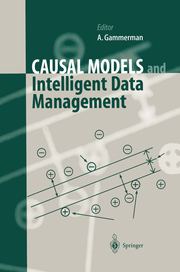-
Zusatztext
-
InhaltsangabeI. Causal Models.- 1. Statistics, Causality, and Graphs.- 1.1 A Century of Denial.- 1.2 Researchers in Search of a Language.- 1.3 Graphs as a Mathematical Language.- 1.4 The Challenge.- References.- 2. Causal Conjecture.- 2.1 Introduction.- 2.2 Variables in a Probability Tree.- 2.3 Causal Uncorrelatedness.- 2.4 Three Positive Causal Relations.- 2.5 Linear Sign.- 2.6 Causal Uncorrelatedness Again.- 2.7 Scored Sign.- 2.8 Tracking.- References.- 3. Who Needs Counterfactuals?.- 3.1 Introduction.- 3.1.1 Decision-Theoretic Framework.- 3.1.2 Unresponsiveness and Insensitivity.- 3.2 Counterfactuals.- 3.3 Problems of Causal Inference.- 3.3.1 Causes of Effects.- 3.3.2 Effects of Causes.- 3.4 The Counterfactual Approach.- 3.4.1 The Counterfactual Setting.- 3.4.2 Counterfactual Assumptions.- 3.5 Homogeneous Population.- 3.5.1 Experiment and Inference.- 3.6 Decision-Analytic Approach.- 3.7 Sheep and Goats.- 3.7.1 ACE.- 3.7.2 Neyman and Fisher.- 3.7.3 Bioequivalence.- 3.8 Causes of Effects.- 3.8.1 A Different Approach?.- 3.9 Conclusion.- References.- 4. Causality: Independence and Determinism.- 4.1 Introduction.- 4.2 Conclusion.- References.- II. Intelligent Data Management.- 5. Intelligent Data Analysis and Deep Understanding.- 5.1 Introduction.- 5.2 The Question: The Strategy.- 5.3 Diminishing Returns.- 5.4 Conclusion.- References.- 6. Learning Algorithms in High Dimensional Spaces.- 6.1 Introduction.- 6.2 SVM for Pattern Recognition.- 6.2.1 Dual Representation of Pattern Recognition.- 6.3 SVM for Regression Estimation.- 6.3.1 Dual Representation of Regression Estimation.- 6.3.2 SVM Applet and Software.- 6.4 Ridge Regression and Least Squares Methods in Dual Variables.- 6.5 Transduction.- 6.6 Conclusion.- References.- 7. Learning Linear Causal Models by MML Sampling.- 7.1 Introduction.- 7.2 Minimum Message Length Principle.- 7.3 The Model Space.- 7.4 The Message Format.- 7.5 Equivalence Sets.- 7.5.1 Small Effects.- 7.5.2 Partial Order Equivalence.- 7.5.3 Structural Equivalence.- 7.5.4 Explanation Length.- 7.6 Finding Good Models.- 7.7 Sampling Control.- 7.8 By-products.- 7.9 Prior Constraints.- 7.10 Test Results.- 7.11 Remarks on Equivalence.- 7.11.1 Small Effect Equivalence.- 7.11.2 Equivalence and Causality.- 7.12 Conclusion.- References.- 8. Game Theory Approach to Multicommodity Flow Network Vulnerability Analysis.- References.- 9. On the Accuracy of Stochastic Complexity Approximations.- 9.1 Introduction.- 9.2 Stochastic Complexity and Its Applications.- 9.3 Approximating the Stochastic Complexity in the Incomplete Data Case.- 9.4 Empirical Results.- 9.4.1 The Problem.- 9.4.2 The Experimental Setting.- 9.4.3 The Algorithms.- 9.4.4 Results.- 9.5 Conclusion.- References.- 10. AI Modelling for Data Quality Control Xiaohui Liu.- 10.1 Introduction.- 10.2 Statistical Approaches to Outliers.- 10.3 Outlier Detection and Analysis.- 10.4 Visual Field Test.- 10.5 Outlier Detection.- 10.5.1 Self-Organising Maps (SOM).- 10.5.2 Applications of SOM.- 10.6 Outlier Analysis by Modelling 'Real Measurements'.- 10.7 Outlier Analysis by Modelling Noisy Data.- 10.7.1 Noise Model I: Noise Definition.- 10.7.2 Noise Model II: Construction.- 10.7.3 Noise Elimination.- 10.8 Concluding Remarks.- References.- 11. New Directions in Text Categorization.- 11.1 Introduction.- 11.2 Machine Learning for Text Classification.- 11.3 Radial Basis Functions and the Bard.- 11.4 An Evolutionary Algorithm for Text Classification.- 11.5 Text Classification by Vocabulary Richness.- 11.6 Text Classification with Frequent Function Words.- 11.7 Do Authors Have Semantic Signatures?.- 11.8 Syntax with Style.- 11.9 Intermezzo.- 11.10 Some Methods of Textual Feature-Finding.- 11.10.1 Progressive Pairwise Chunking.- 11.10.2 Monte Carlo Feature Finding.- 11.10.3 How Long Is a Piece of Substring?.- 11.10.4 Comparative Testing.- 11.11 Which Methods Work Best? - A Benchmarking Study.- 11.12 Discussion.- 11.12.1 In Praise of Semi-Crude Bayesianism.- 11.12.2 What's So Special About Linguisti
-
-
Kurztext
-
Coherent survey on new intelligent data analysis methods with an emphasis on causal inferenceBased on courses held by UNICOMIncludes supplementary material: sn.pub/extras
-
Detailansicht
Causal Models and Intelligent Data Management
ISBN/EAN: 9783642636820
Umbreit-Nr.: 4536862
Sprache:
Englisch
Umfang: x, 185 S., 13 s/w Tab.
Format in cm:
Einband:
kartoniertes Buch
Erschienen am 29.10.2012
Auflage: 1/1999


